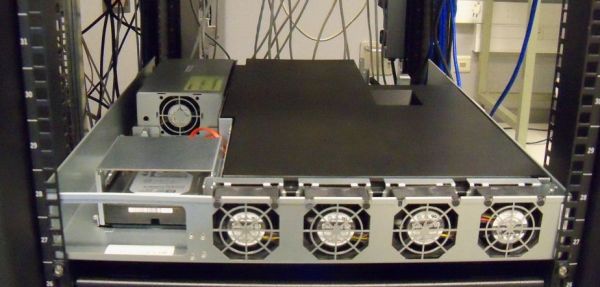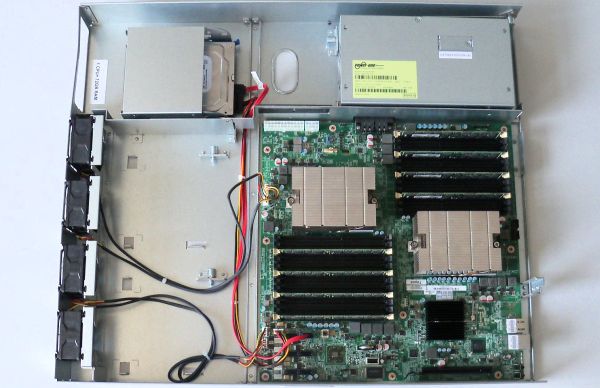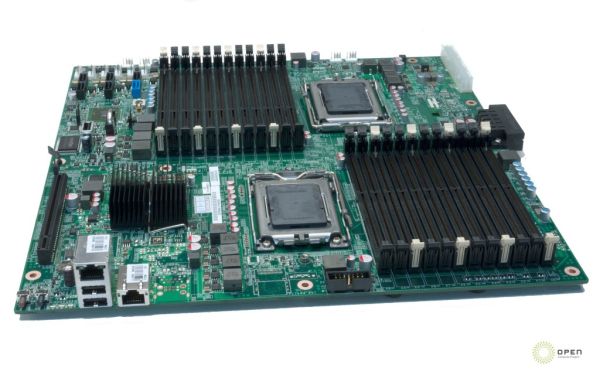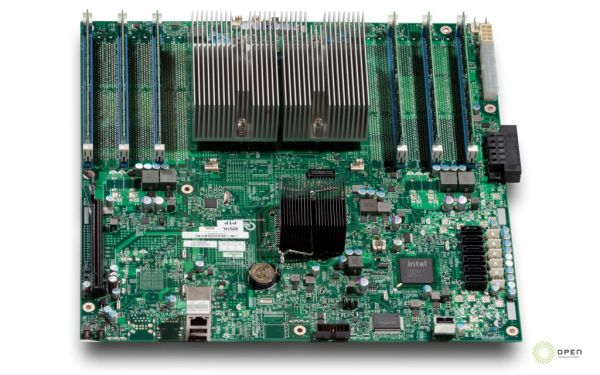Facebook's "Open Compute" Server tested
by Johan De Gelas on November 3, 2011 12:00 AM ESTThe Facebook Server
In the basement of the Palo Alto, California headquarters, three Facebook engineers built Facebook's custom-designed servers, power supplies, server racks, and battery backup systems. The Facebook server had to be much cheaper than the average server, as well as more power efficient.
The first change they made was the chassis height, going for a 1.5U high design as a compromise between density and making the server easier to cool. 1.5U allows them to use taller heatsinks, larger (60mm) lower-RPM fans than the screaming 40mm energy hoggers used in a 1U chassis. The result is that the fans consume only 2% to 4% of the total power, which is pretty amazing as we have seen 1U fans that can consume up to one third of the total system power. It seems that air-cooling in the Open Compute 1.5U server is as efficient as the best 3U servers.
At the same time, Facebook Engineering kept the chassis very simple, without any plastic. It makes the airflow through the server smoother and reduces weight. The bottom plate of one server serves as the top plate for the server beneath it.
Facebook has designed an AMD and an Intel motherboard, both manufactured by Quanta. Much attention was paid to the efficiency of the voltage regulators (94% efficiency). The other trick was again to remove anything that was not absolutely necessary. These motherboards have no BMC, very few USB (2) and NIC ports (2), one expansion slot, and are headless (no videochip).
The only thing that an administrator can do remotely is "reboot over LAN". The idea is that if that does not help, the problem is in 99% of cases severe enough that you have to send an administrator to the server anyway.
The AMD servers are mostly used as Memcached servers, as the four channels of AMD Magny-cours Opterons 6100 are capable of using 12 DIMMs per CPU, or 24 DIMMs in total. That works out to 384GB of caching memory.
In contrast the Facebook Open Compute Xeon servers only have six DIMM slots as they are used for processing intensive tasks such as the PHP "assembling" data servers.














67 Comments
View All Comments
harrkev - Thursday, November 3, 2011 - link
You should look again at the sine-wave plots. Power factor has more to do with the phase of the current and not so much how much like a sine-wave it looks like.As an example, a purely capacitive or purely inductive load will have a perfect sine wave current (but completely out of phase with the voltage), but have a power factor very close to zero...
So, those graphs do not really tell us much unless you actually crank the numbers to calculate the real power factor.
http://en.wikipedia.org/wiki/Power_factor#Non-line...
ezekiel68 - Thursday, November 3, 2011 - link
On page 2:"The next piece in the Facebook puzzle is that the Open Source tools are Memcached."
In fact, the tools are not memchached. Instead, software objects from the PHP/c++ stack, programmed by the engineers, are stored in Memcached. Side note - those in the know pronounce it "mem-cache-dee", emphasizing with the last syllable that it is a network daemon. (similar to how the DNS server "bind" is pronounced "bin-dee") So the next piece is Memcached, but the tools are not 'memcached'.
JohanAnandtech - Thursday, November 3, 2011 - link
That is something that went wrong in the final editing by Jarred. Sorry about that and I feel bad about dragging Jarred into this, but unfortunately that is what happened. As you can see further, "Facebook mostly uses memcached to alleviate database load", I was not under the impression that the "Open Source tools are Memcached. " :-)ezekiel68 - Thursday, November 3, 2011 - link
I was pretty sure it was a mistake and I only mentioned it to have the blemish removed - I've been following and admiring your technical writing since the the early 2000s. Please keep on bringing us great server architecture pieces. Don't worry about Jarred, he's fine too. We all make mistakes.Dug - Thursday, November 3, 2011 - link
I'm curious what the cost would be on the servers compared to something like the HP.Lucian Armasu - Thursday, November 3, 2011 - link
According to SemiAccurate, Facebook is considering Calxeda's recently announced ARM servers, too. It could be a lot more efficient to run something like Facebook on those types of servers.JohanAnandtech - Thursday, November 3, 2011 - link
I personally doubt that very much. The memcached servers are hardly CPU intensive, but a 32 bit ARM processor will not fit the bill. Even when ARM will get 64 bit, it is safe to say that x86 will offer much more DIMM slots. It remains to be seen how the ratio Watt/ RAM cache will be. Until 64 bit ARMs arrive with quite a few memory channels: no go IMHO.And the processing intensive parts of the facebook architecture are going to be very slow on the ARMs.
The funny thing about the ARM presentations is that they assume that virtualization does not exist in the x86 world. A 24 thread x86 CPU with 128 GB can maybe run 30-60 VMs on it, lowering the cost to something like 5-10W per VM. A 5W ARM server is probably not even capable of running one of those machines at a decent speed. You'll be faced with serious management overhead to deal with 30x more servers (or worse!), high response times (single thread performance take a huge dive!) just to save a bit on the power bill.
As a general rule: if the Atom based servers have not made it to the shortlist yet, they sure are not going to replace it by ARM based ones.
tspacie - Thursday, November 3, 2011 - link
The FaceBook servers take a higher line voltage for increased efficiency. What voltage was supplied to the HP server for these tests?JohanAnandtech - Thursday, November 3, 2011 - link
Both servers used 230V. I have added this to benchmark page (Thanks, good question). So in reality the Facebook server can consume slightly less.Alex_Haddock - Thursday, November 3, 2011 - link
TBH we'd position SL class servers for this kind of scenario rather than DL380G7 (which does have a DC power option btw) so not sure it is a relevant comparison. Though I understand using what is available to test.